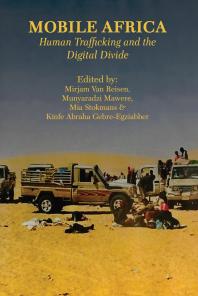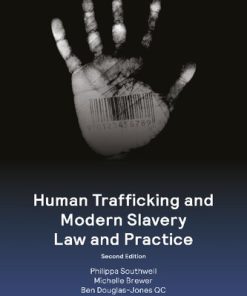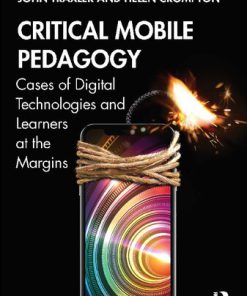Mobile Africa Human Trafficking and the Digital Divide 1st Edition by Mirjam Van Reisen, Munyaradzi Mawere, Kinfe Abraha Gebre Egziabher 9956551619 9789956551613
$50.00 Original price was: $50.00.$25.00Current price is: $25.00.
Mobile Africa Human Trafficking and the Digital Divide 1st Edition by Mirjam Van Reisen, Munyaradzi Mawere, Kinfe Abraha Gebre Egziabher – Ebook PDF Instant Download/Delivery: 9956551619, 9789956551613
Full download Mobile Africa Human Trafficking and the Digital Divide 1st Edition after payment

Product details:
ISBN 10: 9956551619
ISBN 13: 9789956551613
Author: Mirjam Van Reisen, Munyaradzi Mawere, Kinfe Abraha Gebre-Egziabher
What happens at the nexus of the digital divide and human trafficking? This book examines the impact of the introduction of new digital information and communication technology (ICT) � as well as lack of access to digital connectivity � on human trafficking. The different studies presented in the chapters show the realities for people moving along the Central Mediterranean route from the Horn of Africa through Libya to Europe. The authors warn against an over-optimistic view of innovation as a solution and highlight the relationship between technology and the crimes committed against vulnerable people in search of protection. In this volume, the third in a four-part series �Connected and Mobile: Migration and Human Trafficking in Africa�, relevant new theories are proposed as tools to understand the dynamics that appear in mobile Africa. Most importantly, the editors identify critical ethical issues in relation to both technology and human trafficking and the nexus between them, helping explore the dimensions of new responsibilities that need to be defined. The chapters in this book represent a collection of well-documented empirical investigations by a young and diverse group of researchers, addressing critical issues in relation to innovation and the perils of our time.
Mobile Africa Human Trafficking and the Digital Divide 1st Table of contents:
Part I. Theoretical Perspectives
Chapter 1 – Black Holes in the Global Digital Landscape: The Fuelling of Human Trafficking on the Af
Introduction
Methodology
The knowledge society
Architecture of the information network
The geographic misrepresentation of Africa and its effect on latency
Black holes in the global digital landscape
Stuck with this legacy
Digitalisation of human trafficking for ransom
Some empirical evidence
Conclusion
References
Chapter 2 – Network Gatekeepers in Human Trafficking: Profiting from the Misery of Eritreans in the
Introduction
Network gatekeepers
The uneven digitally-connected world
Methodology
The relationship between the gated and the gatekeepers
Alternative information sources
Ability to produce and distribute information
Relationship between the gated and the gatekeepers
Political power
The dependence of Eritrean refugees on human traffickers
Alternatives to migration to Europe
Alternative migration routes or options
Autonomy to choose human smugglers and traffickers
Conclusion
References
Chapter 3 – Bound Together in the Digital Era: Poverty, Migration and Human Trafficking
Introduction
The relationship between human trafficking and mixed migration
Poverty, the main driver of mixed migration
The cycle of poverty and human trafficking
Deliberate poverty
Trafficking in a digital age
Slavery and trafficking for ransom: A profitable industry
An African perspective on combatting human trafficking through the eradication of poverty
Conclusion
References
Chapter 4 – Tortured on Camera: The Use of ICTs in Trafficking for Ransom
Introduction
Research questions
Research method
Documentaries
Sound of Torture
Under the Skin
It Will Be Chaos
Time periods
Theoretical framework
Results
Period 1: 2009–2014
Period 2: 2014–2015
Period 3: 2016-ongoing
Conclusion
References
Part II. Traumatising Trajectories
Chapter 5 – ‘Sons of Isaias’: Slavery and Indefinite National Service in Eritrea
Introduction
Escaping slavery
Methodology
National Service in Eritrea
Warsay Yikaalo
Control of labour and the economy
Control of information
Disruption of social relationships
Choosing to flee
Institutionalised forced labour
No change with peace: The exodus continues
Conclusion
References
Chapter 6 – Journeys of Youth in Digital Africa: Pulled by Connectivity
Introduction
Black holes
Nudging
Methodology
Eritrea: Understanding children and youth
Technology and connectivity in Eritrea
Upon arrival in Ethiopia: Hitsats camp
The conditions in camp
Connectivity and mobile phone use
Children and youth in Hitsats and mobile phones
Social media and secondary movement
Reasons for leaving: Is it only (digital) information?
Conclusion
Acknowledgement
References
Chapter 7 – Not a People’s Peace: Eritrean Refugees Fleeing from the Horn of African to Kenya
Introduction
Research question
Methodology
Profile of respondents
Number of newly-arrived Eritrean refugees in Kenya
Departure locations
Reasons for fleeing
Challenges faced by Eritrean refugees transiting to Kenya
Respondent 1
Respondent 2
Respondent 3
Respondent 4
Respondent 5
Respondent 6
Respondent 7
Respondent 8
Respondent 9
Government and non-government assistance
Solutions to refugee problems
Conclusion and recommendations
Limitations of the study
References
Chapter 8 – Israel’s ‘Voluntary’ Return Policy to Expel Refugees: The Illusion of Choice
Introduction
The situation in Israel
Imprisonment – The illusion of choice
Saharonim
Holot
Deportation
Confidential agreements
Promises regarding about third countries
Deportation to Rwanda
Deportation to Uganda
Number of Eritreans and Sudanese deported
Situation after deportation
Conclusion
References
Chapter 9 – The Plight of Refugees in Agadez in Niger: From Crossroad to Dead End
Introduction: Migration, a capricious market
Immersion in Agadez
Migrants
Refugees
Smugglers
Conclusion: Roaming migrants, blocked asylum seekers, unemployed smugglers
References
Chapter 10 – Lawless Libya: Unprotected Refugees Kept Powerless and Silent
Introduction
Methodology
Theory of gatekeeping
Situation in Libya
Gatekeeping in Libya and the situation of refugees as a gated community
Autonomy and alternative information sources
Information production and distribution
Relationship between refugees and the gatekeepers
Political power
Conclusion
References
Chapter 11 – The Voices of African Migrants in Europe: Isaka’s Resilience
Introduction
Isaka’s story
Deciding to leave Guinea
Prisons in Libya
Departure
Across the Mediterranean to Italy
Migration
A problem for senders, receivers and the migrants themselves
In search of dignity and safety
State failure
Limitations of the theory of push and pull
Migrant journeys: Filling a gap in migration studies
Research objectives
Research methodology
Results
Down, but not out
Minors adrift
‘Don’t destroy my hope’
Contradictions and hidden layers of reality
Dreams of helping themselves – and others
Looking forward, not back
Conclusion
References
Chapter 12 – Desperate Journeys: The Need for Trauma Support for Refugees
Introduction
Research question and objectives
Theoretical framework
Trauma of refugees
Social and economic resilience
Psychological effects of trauma on decision to migrate
Research method
Selection of participants
Design of the study
The trauma support programme (SHLCPTS)
Measurement scales
Ethical considerations
Results
Did the SHLCPTS reduce traumatic stress?
Did the SHLCPTS increase social and economic resilience?
Suitability of the SHLCPTS as an app in a refugee camp
Discussion
Conclusion
Acknowledgement
References
Chapter 13 – Identifying Survivors of Torture: “I Never Told What Happened to Me in the Sinai”
Introduction
Methodology
Definitions: Human trafficking, slavery and torture
Human trafficking
Slavery
Torture
Procedures for the absorption of torture camp survivors
Identification of slavery survivors
Imprisonment of torture survivors under the Entry to Israel Law
Government policy on the rights of torture survivors
The incarceration of asylum seekers, including survivors of trafficking, torture and slavery
Identification of victims of torture by non-governmental organisations
Conclusion
References
Part III. Psychological Impact of Ongoing Trauma
Chapter 14 – Refugee Parenting in Ethiopia and the Netherlands: Being an Eritrean Parent Outside the
Introduction
Trauma, parenting and child development
The specific impact of trauma on parental self-efficacy
Parental self-efficacy and parenting
Post-traumatic stress and parenting
Method
Sample
Procedure
Measures
Results
High level of parental self-efficacy
Limited use of parental self-efficacy sources
High level of trauma
Discussion
Conclusion
Limitations
Acknowledgement
References
Chapter 15 – Journeys of Trust and Hope: Unaccompanied Minors from Eritrea in Ethiopia and the Nethe
Introduction
Feelings as information
Context
Methodology
Ethical considerations
Ethiopia: Trust in the refugee camps
The Netherlands: Dealing with a new hierarchy
Resilience and aspirations: Strategic behaviour versus cooperation
Conclusions
Acknowledgement
References
Chapter 16 – Refugees’ Right to Family Unity in Belgium and the Netherlands: ‘Life is Nothing wi
Introduction
The right to family reunification
Research methodology
Legal background
International law
European law
The Netherlands
Belgium
Constraints on family reunification
The story of Haile and Sophia
Lack of understanding of the process
Onerous family reunification requirements
Inability to collect documents
Official documentation
Inconsistent requirements
Absence of diplomatic relations
Discretionary or unjustified practices
Lack of alternatives to documentation
Conclusion
References
Part IV. Problem Framing
Chapter 17 – The Representation of Human Trafficking in Documentaries: Vulnerable Victims and Shadow
Introduction
Methodology
Theoretical framework
Frame
Problem definition
Push and pull theory
Human trafficking and smuggling
Genderised victims and perpetrators
Trauma
Agency
Five documentaries
It Will be Chaos (2018)
Sound of Torture (2013)
Under the Skin (2014)
The Gatekeepers of Europe (2018)
The Hunt for the General (2016)
Portrayal of refugees
Portrayal of human traffickers and smugglers
Genderisation of victimhood
Trauma
Agency
Conclusion
References
Chapter 18 – Language Dominance in the Framing of Problems and Solutions: The Language of Mobility
Introduction
Method
Dominant Eurocentric formalisations
Contrapuntal developments in the language of mobility
A discussion model
Travels from periphery to the centre (view 1)
Receiving travellers in Europe (view 2)
Remittances and aid (view 3)
Super-colonialism (view 4)
Confrontation: Exposing the ideological framings at play in views 2 and 4
Creation of a ‘straw man’
The criminalisation of migration
African versus European lenses
Conclusion
References
Part V. Extraterritorialisation of Migration and International Responsibilities
Chapter 19 – The Shaping of the EU’s Migration Policy: The Tragedy of Lampedusa as a Turning Point
Introduction
Agenda setting
Lampedusa: The window opens
Framing ‘the problem’ following the shipwreck
A numbers game
The policies: EU migration policy
European Agenda on Migration
Frontex
Externalisation of borders
Deals with third countries
The political mood
Conclusion
References
Chapter 20 – Sudan and the EU: Uneasy Bedfellows
Introduction
Sudanese security state
National Intelligence and Security Service
Police
Armed forces
Scale of the challenge
European response
EU-Sudan security cooperation
Government complicity in human trafficking
Blocking the Mediterranean crossing
Right to asylum or forcible repatriation?
The Netherlands
Italy
Belgium
France
United Kingdom
Conclusion
References
Chapter 21 – Uncomfortable Aid: INGOs in Eritrea
Introduction
Theoretical framework
Methodology
Policy framework for government control
Restrictions on international cooperation
Humanitarian assistance
2001 crackdown and international response
Continued closing of space for INGOs
Ongoing crimes against humanity
INGO engagement in Eritrea
Requirement to work only with government
Complicity with forced labour
Putting local staff in danger
Promoting the government’s agenda
Legitimising the government
Conclusion
References
Chapter 22 – Complicity in Torture: The Accountability of the EU for Human Rights Abuses against Ref
Introduction
The abuse of refugees and migrants in Libya
Alleged European complicity
Possible accountability options
Long-term and sustainable solutions
The end justifies the means
Conclusion
References
Chapter 23 – Playing Cat and Mouse: How Europe Evades Responsibility for its Role in Human Rights Ab
Introduction
Examples of migration control policies
Italian and European support for Libya
Returns from Libya to countries of origin
Israel’s agreements with Rwanda and Uganda
Responsibility of states
State actors
Non-state actors
Derived responsibility
Responsibility of the EU and its agencies
The European Union
Frontex
EASO
Conclusion
References
About the Authors
Back cover
People also search for Mobile Africa Human Trafficking and the Digital Divide 1st :
a digital divide
africa mobile penetration
the digital divide in africa
global digital divide
You may also like…
Arts - Graphic Arts
Commercial & Financial Law
Uncategorized
Uncategorized
Psychology - Psychotherapy
Jurisprudence & Law - Criminal Law & Procedure
Human Trafficking and Modern Slavery Law and Practice 2nd Edition Philippa Southwell
Forensic Science
Education Studies & Teaching - Adult & Continuing Education











